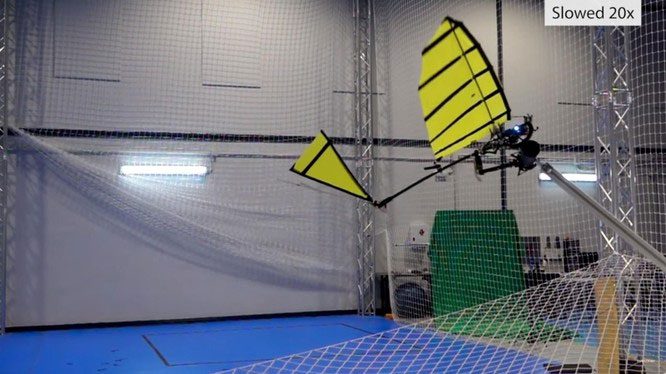A group of scientists researching flapping robots has developed a new technique to create mechanical claws automated based on Artificial Intelligence (AI), allowing bird-like robots to perch on horizontal bars.
Taiwan’s Foxconn sells all shares of a Chinese chip manufacturing group. Robots maintaining wind turbine blades are four times faster than conventional methods. The US strikes another blow to China’s chip industry, adding 36 companies to the blacklist.

Flapping robot ornithopter flying and perching on a horizontal bar. (Image from New Scientist).
Landing and perching on a branch is easy for most bird species, but quite challenging for flying robots due to their larger size and the complexity of landing on a horizontal bar.
Making flying robots behave like birds is one challenge, but getting bird-like robots to land like birds is an entirely different and much harder problem. There are many factors to consider, such as speed, timing, impact force, distance estimation, and balance, among others. The task is so complex that no flapping robot (ornithopter) has been able to achieve this until now.
The bird-like robot equipped with claws can be used to perch on branches that the flying robot approaches. The method of perching on branches or similar objects could be beneficial for activities such as collecting samples in hard-to-reach areas or quietly observing wildlife in their natural habitats, as well as various other activities similar to birds.
Postdoctoral researcher Raphael Zufferey at the Laboratory of Intelligent Systems (LIS) and Biorobotics ab (BioRob) of the Swiss Federal Institute of Technology in Lausanne developed a robotic bird (ornithopter) with a wingspan of 1.5 meters and weighing 700 grams, which can use its claws to perch on branches in the laboratory after a short flight. He created and tested the robot in collaboration with colleagues at the University of Seville, Spain, where the ornithopter was developed as part of the European GRIFFIN project.
The team of scientists tests the flapping ornithopter robot flying and perching on a horizontal bar. (Video from New Scientist)
“This is the first stage of a larger project. Once an ornithopter can land completely autonomously on a branch, the bird-robot will be capable of performing specific tasks such as collecting biological samples or conducting measurements or discreet observations from a branch. Additionally, the ornithopter can land on artificial structures or difficult positions, opening up many more fields of application,” said Zufferey.
According to him, the ability to land on a horizontal bar could provide a more efficient method for ornithopters, similar to many unmanned aerial vehicles (UAVs) with limited battery life, which may descend to recharge using solar energy, making the flying vehicles ideal for long-range or prolonged missions.
Dr. Zufferey commented: “This is a significant advancement in the use of flapping robots, which can currently only perform free flights for complex missions and essential applications in the real world.”
Maximizing power and precision; minimizing weight and speed
The technical issues related to an ornithopter’s ability to land on a horizontal bar without any external commands require controlling numerous factors that nature has balanced perfectly. The ornithopter must be capable of significantly slowing down when landing while still maintaining a flying state. The claws must be strong enough to grip the horizontal bar and support the weight of the robot, yet not so heavy that the robot cannot ascend. Zufferey noted: “That’s one reason why we had to use one claw instead of two. Additionally, the robot needs to be able to sense its surrounding environment and the horizontal bar in front of it concerning its position, speed, and trajectory.”
The researchers achieved these results by equipping the ornithopter with a positioning system and integrated computer based on Artificial Intelligence (AI), supplemented with a system that records external movements to help the bird-robot’s AI determine its position relative to the landing bar. The claw component of the ornithopter was finely tuned to compensate for the up-and-down oscillations of flight as the robot focused on identifying the landing bar and gripping it. These artificial claws are designed to absorb the momentum of the robot when it makes contact, locking quickly and securely to withstand the robot’s weight. After landing, the robot remains perched on the horizontal bar without expending energy.
By implementing all these factors, Zufferey and his colleagues successfully created not just one but two ornithopters equipped with claws to replicate the landing results of the robot.
In an interview with New Scientist, Zufferey explained that achieving this remarkable feat required a few adjustments from the actual behavior of birds. Although the spring-loaded claws grip a 6 cm diameter horizontal bar similar to their zoological inspiration, the final approach differs from real-world counterparts. In nature, birds hover above the horizontal bar for a moment before touching down. Zufferey’s invention simply slows down as it nears the final destination, using optical camera assessments, thereby allowing the spring-loaded claws to activate within 25 milliseconds, according to a research results article published in Nature Communications.
In the future, Dr. Zufferey’s research team will continue to refine and update the automation technology for clawed bird-robots to operate in outdoor environments.
“Currently, flight tests are conducted indoors because we need a controlled flight area with precise positioning capabilities from the motion recording system. In the future, we want to enhance the robot’s autonomy to perform landing tasks and operate outdoors in more complex environments,” he added.
The new clawed ornithopter is not yet ready for outdoor use. The robots currently operate “dependent on accurate localization data from the motion recording system” and have not been optimized for unpredictable environments. However, once these issues are resolved, researchers believe that bird-robots could perform many tasks in hard-to-reach locations or track noise-sensitive wildlife in nature for research purposes.


















































